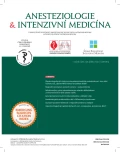Anaesthetic management of patients with Williams syndrome
Authors:
P. Nosková
Authors‘ workplace:
Klinika anesteziologie, resuscitace a intenzivní medicíny, 1. lékařská fakulta Univerzity Karlovy a Všeobecná fakultní nemocnice v Praze
Published in:
Anest. intenziv. Med., 29, 2018, č. 3, s. 148-150
Category:
Special article
Overview
Williams syndrome is caused by a genetic abnormality. The most common symptoms are heart defects and unusual facial features. Patients are known to have increased risk of adverse events during anaesthesia and difficult airway. The article concerns risk assessment and practical anaesthetic management of patients with Williams syndrome.
Keywords:
Williams syndrome – coronary artery disease – sudden death – difficult airway – anaesthetic management
Sources
1. Morris CA, Thomas IT, Greenberg F. Williams syndrome: autosomal dominant inheritance. Am J Med Genet. 1993;47:478−481.
2. Williamsův syndrom. Brožura občanského sdružení Willík. Praha, 2010.
3. Burch TM, Mc Gowan FX, Kuussmann BD, et al. Congenital supravalvular stenosis and sudden death associated with anesthesia: what's the mystery? Anesth Analg. 2008;107:1848−1854.
4. Committee on Genetics American Academy of Pediatrics health care supervision for children with Williams syndrome. Pediatrics. 2001;107:1192−1204.
5. Matisoff AJ, Olivieri L, Schwartz JM, et al. Risk assessment and anesthetic management of patients with Williams syndrome: a comprehensive review. Pediatr anesth. 2015;1−9.
Labels
Anaesthesiology, Resuscitation and Inten Intensive Care MedicineArticle was published in
Anaesthesiology and Intensive Care Medicine

2018 Issue 3
Most read in this issue
- Urgent infraglottic airway – cricothyroid puncture, cricothyrotomy and bougie-assisted cricothyrotomy (BACT)
- Generalizovaný konvulzivní status epilepticus v dětském věku
- Regional anaesthesia for shoulder surgery – new trends
- Corticosteroids in regional anaesthesia and analgesia – state of the art
